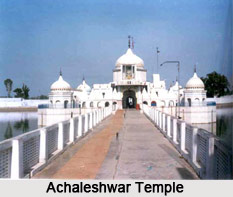 Achaleswaram Temple is a highly revered shrine situated at Achaleswaram, in Thiruvarur District of Tamil Nadu. The temple is situated on the southern part of the Tyagarajar Temple at Thiruvarur. Achaleswaram Temple is regarded as the 88th in the series of Tevara Stalams in Chola Nadu south of the Kaveri River. The temple is also known as "Tiruvarur Araneri Temple". The temple is dedicated to Lord Shiva in the form of Achaleswaram along with his consort Achaleswari. It is believed that Saint Appar is said to have glorified this temple through his pathigams. The construction of the temple is after the model of the Thanjavur Pragadeeswarar Temple. Saivite saint Tirunavukkaracar has praised the temple in his Tevaram hymns.
Achaleswaram Temple is a highly revered shrine situated at Achaleswaram, in Thiruvarur District of Tamil Nadu. The temple is situated on the southern part of the Tyagarajar Temple at Thiruvarur. Achaleswaram Temple is regarded as the 88th in the series of Tevara Stalams in Chola Nadu south of the Kaveri River. The temple is also known as "Tiruvarur Araneri Temple". The temple is dedicated to Lord Shiva in the form of Achaleswaram along with his consort Achaleswari. It is believed that Saint Appar is said to have glorified this temple through his pathigams. The construction of the temple is after the model of the Thanjavur Pragadeeswarar Temple. Saivite saint Tirunavukkaracar has praised the temple in his Tevaram hymns.
The Chola Queen Sembian Mahadevi rebuilt this temple in stone during the 10th century. The temple faces towards the west and has a sanctum and an "Ardha Mandapam". Inscriptions from the period of Rajaraja Chola are found here. The niche images include those of "Ardhanareeswarar", "Goddess Durga", "Bhikshatanar", "Lord Brahma", "Lingodbhavar", "Lord Dakshinamurthy", "Sage Agastyar" and "Natarajar".
Legend of Achaleswaram Temple
Naminandi Adigal, one of the 63 Nayanmars, was worshipping Lord Achaleswarar every day without fail. One evening when he came to the temple, he noticed that the lamp was nearly extinguishing as the ghee was exhausted. He approached some neighbours for ghee. They belonged to a different faith and mocked at Naminandi Adigal. Being mocked by the neighbours, he prayed to Lord Shiva who instructed to bring water from the tank in the temple and light the lamp. He lighted all the lamps in the temple with water instead of ghee. The whole temple became bright as in the day with sun rays.
Hearing the wonderful devotion of Naminandi Adigal, the Chola king made him the head of the temple administration and offered all help to conduct the festivals in the temple. The Jains who mocked at Adigal regretted their attitude. The shade of the presiding deity would fall only eastward.





















